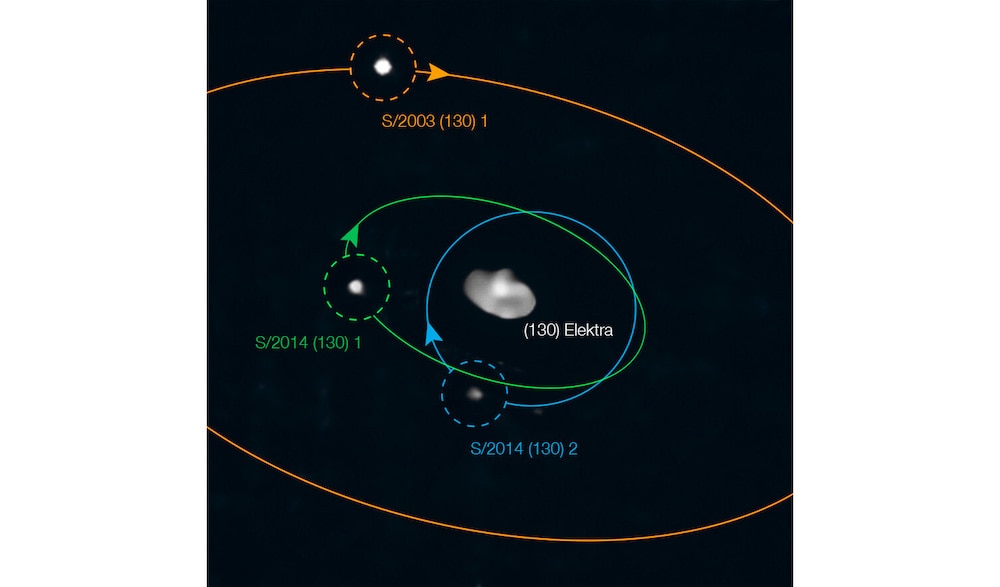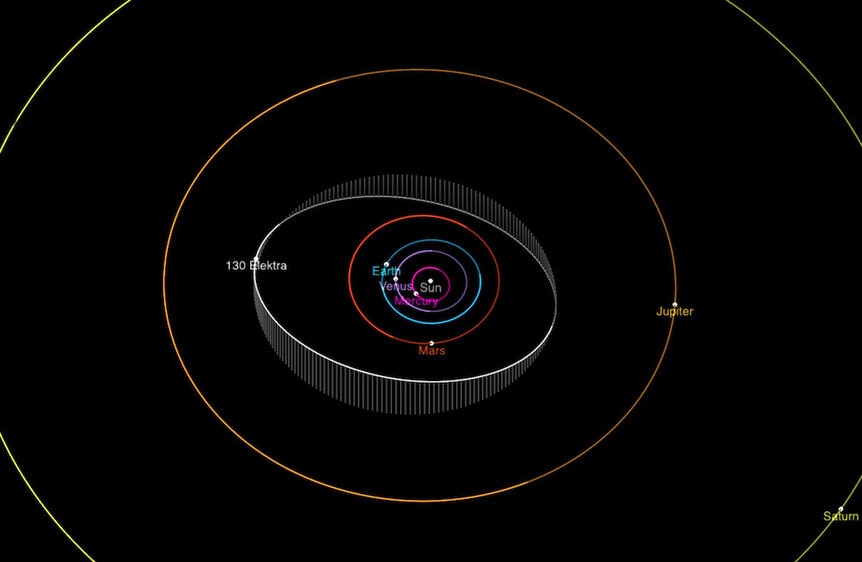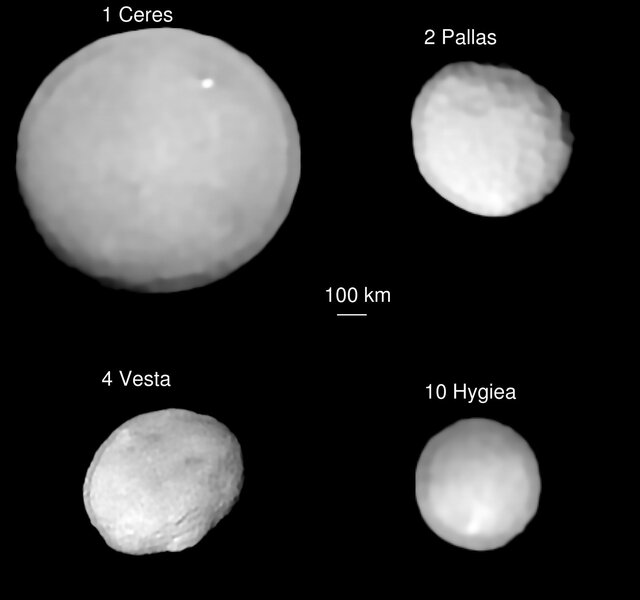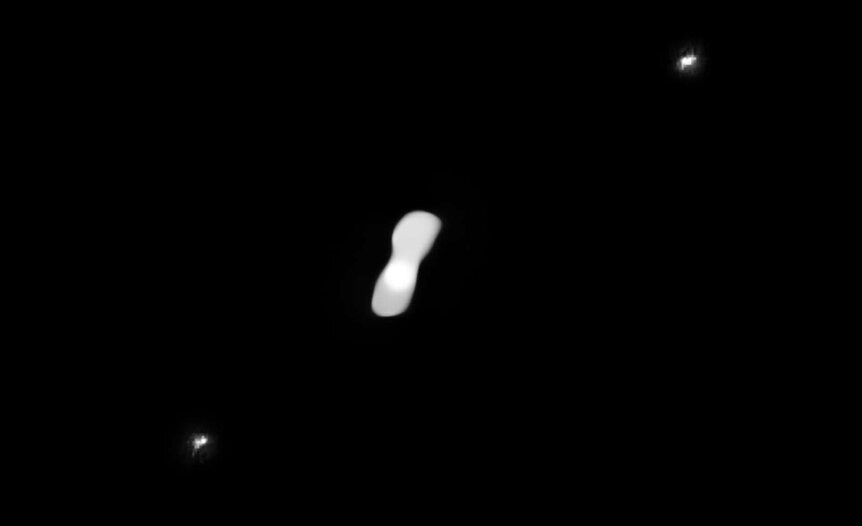Create a free profile to get unlimited access to exclusive videos, sweepstakes, and more!
Quadruple asteroid!
A newly discovered third moon for Elektra makes it the first known quadruple asteroid.

We've known for a long time that asteroids can have moons — heck, in a few months NASA is slamming a probe into a tiny moon to test the idea that we can move one out of the way should it be headed for Earth — and it's estimated that a significant fraction of asteroids have smaller ones orbiting them.
A handful of trinary asteroids have been found, where the main rock is orbited by two others. But now, astronomers have found the first known quadruple (technically a quaternary) asteroid: 130 Elektra, which has three moons! At least.
Elektra is one of the larger main-belt asteroids between Mars and Jupiter, discovered in 1873. It's a lumpy potato, as so many asteroids are, about 260 x 200 x 164 kilometers in size. It's on a mildly elliptical orbit which is decently tipped relative to the plane of the solar system by about 22°.
Observations in 2003 using the huge Keck telescope revealed the first satellite, which is perhaps 6 kilometers across and has an orbit about 1,300 kilometers from Elektra. That large distance and relative size made it easier to discover; the second one is only 2 kilometers wide and closer in at 500 kilometers.
The incredible high-resolution camera SPHERE on the huge Very Large Telescope was used to find the second moon in a series of observations taken over three weeks in December 2014.
SPHERE is capable of ridiculously detailed images, and mounted on a 10-meter telescope it can also spot very faint objects. I point this out because the third moon was discovered recently in those older images using new processing techniques (link to paper). The moon was in the data the whole time, but it was invisible to the processing techniques available in 2005.
Any bright object seen in a telescope will have a halo around it, light scattered by the optics. In this case the glow from Elektra's halo completely hid the moon at the time, but the team of scientists reprocessing the old data were able to model that glow using a sophisticated algorithm and subtract it from the image.
When they did, the third moon popped out in images taken over three nights in the original 2014 observing campaign. Unfortunately the geometry of the moon and Elektra at the time make it impossible to get a good orbital fit for the moon, but they estimate it's about a 1.6 km across and has an elliptical orbit with an orbital period of about 16 hours. The orbit itself is about 688 km across on its long axis. That means on average this third moon is 344 km from Elektra, which is close, considering the asteroid was about 270 million km from Earth when the images were taken.
To drive home how difficult this was, the third moon is about 1/1,500th as bright as Elektra itself, but the halo from the main asteroid was 1/150th as bright, ten times brighter than the moon. I've done exactly this sort imaging processing work with Hubble images, and it's painstaking and difficult. This is impressive work.
The naming convention for asteroid moons is to use the letter S for satellite followed by the year it was discovered, the number of the parent asteroid in parentheses, and a sequential number for the order of discovery in that year. The first then is S/2003 (130) 1, the second S/2014 (130) 1, and the third new one S/2014 (130) 2. It's a bit hard to read, but a consistent naming convention is pretty important when you're trying to keep track of all these beasties.
How did these moons form? Likely from an impact, another asteroid slamming into the main body of Elektra and ejecting debris which then coalesced to form the moons. Maybe it took multiple impacts to form them, since the orbits are all so different. This is similar to how our own Moon formed, and Pluto's smaller moons may have been created the same way in a massive impact that formed its main moon Charon.
Finding moons around asteroids is critical. It's not possible to get an accurate mass for an asteroid if it's all by its lonesome — it can be estimated, if we have an idea of its size and composition, but that's iffy — but if it has a moon then we can use equations first derived centuries ago by Johannes Kepler to determine the mass of the parent asteroid. If we know the size and the mass we can get the density, and that's the goal: This tells us a lot about the composition. Metal is much denser than rock, and some asteroids are rubble piles, extremely low density-bags of rocks held together by gravity. A moon or two orbiting an asteroid brings the gift of knowledge to planetary scientists.
In a sense this work is a proof of concept as much as a discovery, showing that it's possible to get even more detailed and deeper images from observations already taken. SPHERE is a busy little bee, and has been used a lot to look at asteroids. I imagine this technique will now be used to look at these older observations to mine them for more treasures. How many other wee little satellites will be discovered around previously observed rocks? And how many moons can an asteroid have? Soon we may know a lot better.






























